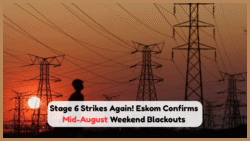Eskom Stage 6 Load Shedding – In a surprising turn of events, a leaked Eskom Stage 6 load shedding plan for August 2025 has shaken public confidence as the nation braces for possibly the worst blackouts yet. South Africa, still recovering from an earlier Stage 6 crisis in February 2025, may now face even more severe disruptions. With multiple generating units recently tripped at Camden, Majuba and Medupi—causing sudden power outages and an emergency escalation to Stage 6—residents and businesses are scrambling to prepare. Eskom officially declared Stage 6 at around 01:30 AM on 23 February 2025, after unexpected unit failures removed nearly 3,864 MW of generation capacity, compounded by another 7,506 MW offline for planned maintenance.Though Eskom later expressed regret and promised swift restoration, energy analysts warn that insufficient maintenance, boiler tube leaks, and ageing infrastructure could intensify load shedding this winter. Rumours of the leaked August schedule suggest multiple days of extended outages—reigniting panic buying and urgent demand reduction advice across the country. Eskom insists the forecast remains stable: if unplanned outages stay below 13,000 MW, only minor shedding (up to Stage 2) will be needed until 31 August 2025. The leaked document, however, appears to anticipate generating availability well below that threshold, prompting widespread alarm and debate over the utility’s credibility.This article explores what the leaked Stage 6 plan implies, why August may be particularly vulnerable, and how stakeholders—households, businesses, and government agencies—can navigate the challenges. It draws on official statements, expert commentary, and historical patterns to provide a full picture of the crisis. Contact details for departments are also included so readers can seek official guidance or support.

The Leak: What the August Schedule Reveals
This section outlines key claims from the leaked August Stage 6 schedule and what they mean if implemented.
- Forecasted daily outages at multiple stages, peaking at Stage 6 for several days.
- Specific power stations cited: Camden, Majuba, Medupi, and Kusile facing recurring trips.
- Gaps in diesel reserves and emergency capacity flagged.
Leaked Daily Outage Table
| Date (August 2025) | Stage Forecast | Expected Load Reduction (MW) | Estimated Hours per Day | Notes |
|---|---|---|---|---|
| 1–3 August | Stage 4 | ~4,000 | ~24 | Moderate risk level |
| 4–6 August | Stage 5 | ~5,000 | ~30 | Emerging stress |
| 7–10 August | Stage 6 | ~6,000 | ~36 | Severe interruptions |
| 11–14 August | Stage 5 | ~5,000 | ~30 | Downgrade expected |
| 15–17 August | Stage 4 | ~4,000 | ~24 | Slight relief |
| 18–21 August | Stage 6 | ~6,000 | ~36 | Load uncertainty high |
| 22–31 August | Stage 3–4 | ~3,000–4,000 | ~18–24 | Soft recovery phase |
Implications If True
- Multiple continuous days of severe blackouts (Stage 6) could devastate small businesses.
- Consumer panic likely to rise: generators, inverters, gas stoves in demand.
- Risk of deepening mistrust in official Eskom forecasts.
Why August Might Be Worse Than February
Examines factors that could worsen power shortages in August.
- Peak winter demand: heating, lighting draw more electricity.
- Planned maintenance backlog: units possibly still offline.
- Lower diesel reserves compared to February spike.
Key Technical Factors:
- No new generation units added since early 2025, so margin tight.
- Eskom’s winter outlook assumed unplanned outages under 13,000 MW; but in February those spiked to over 17,000 MW which drove Stage 6 escalation.
- Boiler tube leaks may not be fully resolved; engineers warned previous failures were preventable with proper maintenance.
Eskom’s Response and Official Guidance
Summarizes public statements and preparations made by Eskom and government.
- Eskom apologized for February 2025 escalation, and promised restoration by week’s end.
- Official winter outlook (published 5 May 2025) states load shedding unlikely before 31 August if outages remain below 13,000 MW and stage capped at Stage 2.
- Government urging citizens to reduce demand during peak hours, rely on official communication channels and the MyEskom app.
Key Eskom Commitments
| Commitment | Description |
|---|---|
| Weekly capacity updates | Regular load status reports |
| Prioritised return of major units | Accelerated maintenance at Camden and Majuba |
| Diesel reserve replenishment | Preparedness for future outages |
| Public communication improvements | Direct updates via website and apps |
Expert Analysis and Criticism
Summarizes expert opinions and industry voices on the leaked plan and Eskom’s performance.
- Energy analysts cite poor maintenance and ageing infrastructure as root causes, rather than sabotage.
- EE Business Intelligence warns public messaging has downplayed risk until last minute.
- Civil nuclear engineers argue boiler tube leaks—and resulting Stage 6—were preventable if maintenance had been properly executed.
“It’s … due to not handling the control parameters properly … reliability maintenance … collapsed”.
Public sentiment on Reddit underscores frustration—the speed from Stage 3 to Stage 6 shocked many users.
“We were sitting on hour 35 of a power outage … when it was announced … Wow go to bed at stage 3 and these cowards push us to stage 6 in the middle of the night.”
Public Preparedness Advice
What households and businesses can do to brace for potential outages in August.
- Charge essential devices and keep power banks ready.
- Install surge protectors and use energy‑efficient appliances.
- Consider gas or solar geysers and stoves where possible.
- Shift heavy power use outside peak hours (5–9 AM / 5–9 PM).
Departmental Contacts for Support
Relevant contact details for national and provincial energy departments and Eskom support.
- Eskom National Call Centre: +27‑86‑003‑7566 (available 24/7)
- Department of Mineral Resources & Energy (DMRE): info@dmre.gov.za | +27‑12‑444‑3000
- Gauteng Energy Directorate: energy@gauteng.gov.za | +27‑11‑355‑1000
- Western Cape Energy Office: energyinfo@westerncape.gov.za | +27‑21‑483‑4200
Table of Key Risks and Mitigations
A comprehensive overview of threats versus recommended responses in the leaked plan scenario.
| Risk Factor | Consequence | Mitigation Strategy |
|---|---|---|
| Stage 6 sustained outages | Business disruption and losses | Backup generators, business continuity plans |
| Fuel and diesel shortages | Extended outages, blackouts | Secure emergency fuel, invest in hybrid systems |
| Poor maintenance and equipment failures | Repeated trips and outages | Demand transparency, press for accelerated maintenance |
| Public panic and misinformation | Hoarding, stress on supply chains | Trust official channels; fact‑check sources |
| Inaccurate forecasting | Unprepared communities | Seek real‑time updates via Eskom platforms |
Key Takeaways
- The leaked August Stage 6 plan, if accurate, signals a major escalation of risk through extended blackouts.
- Eskom’s official outlook remains cautiously optimistic—limited less severe stages only if system performance holds.
- Experts emphasise that prior Stage 6 incidents were avoidable with better maintenance and planning.
- Public readiness, early communication, and-demand reduction are vital to reduce impact.
- Persistent issues—especially boiler leaks and ageing infrastructure—underscore the need for urgent overhaul and transparency.
While the leaked August Stage 6 plan has triggered fear and speculation, the actual outcome hinges on Eskom’s ability to maintain system reliability and manage outages below critical thresholds. If successful, the worst may yet be avoided. But if the leaked forecasts hold true, South African households and businesses will face their toughest power test yet. Staying informed, preparing in advance, and monitoring official channels remains the best defence for now.
FAQs of Eskom Stage 6 Load Shedding
- What exactly is Stage 6 load shedding?
Stage 6 involves shedding approximately 6,000 MW—leading to frequent, multi‑hour blackouts across regions. - When did the last official Stage 6 occur?
It was declared from 23 February 2025 until restored capacity gradually reduced shedding by 26 February. - Is August 2025 officially at risk?
While officially Eskom forecasts no load shedding beyond Stage 2 through 31 August, the leaked plan suggests a far more severe scenario—though it remains unverified. - How can I track real-time load shedding schedules?
Use the official MyEskom app or Eskom’s load shedding portal; avoid relying on unverified WhatsApp or social media posts. - What steps can businesses take now?
Arrange backup power or inverter systems, reduce non-essential usage during peak times, and develop contingency operations plans.
What measures can individuals take to minimize the impact of Stage 6 load shedding?
Use energy-efficient appliances and limit electricity usage during peak hours.
How can businesses prepare for potential Stage 6 load shedding disruptions?
Implement backup power sources and contingency plans for uninterrupted operations.









